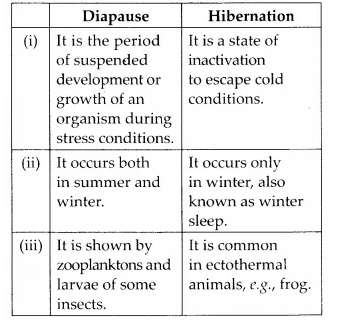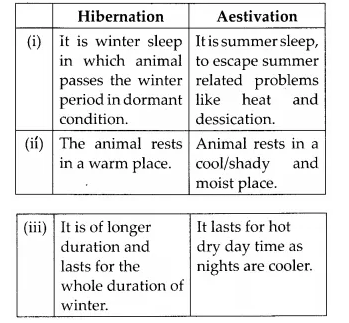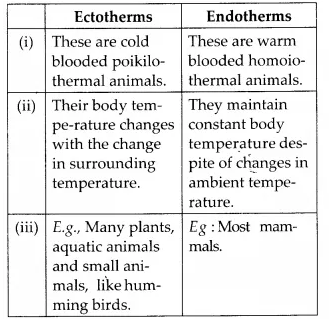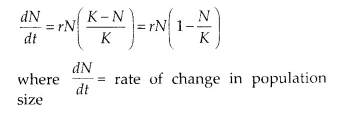NCERT Solutions for Class-12 Biology Chapter-13 Organisms and Populations
Solution: Diapause is different from hibernation. The table below shows the differences between them,

Question 2. If a marine fish is placed in a freshwater aquarium/will the fish be able to survive? Why or why not?
Solution: If a marine fish is placed in a freshwater aquarium, then its chances of survival will diminish. This is because their bodies are adapted to high salt concentrations in the marine environment. In freshwater conditions, they are unable to regulate the water entering the body (through osmosis). Water enters their body due to the hypotonic environment outside. This results in the swelling up of the body, eventually leading to the death of the marine fish.
Question 3. Define phenotypic adaptation. Give one example.
Solution: Phenotypic adaptation involves non-genetic changes in individuals such as physiological modifications like acclimatization or behavioural changes.
Question 4. Most living organisms cannot survive at temperatures above 45°C. How are some microbes able to live in habitats with temperatures exceeding 100°C?
Solution: organisms survive at a temperature range of 0° to 40°C or less. However, there are some notable exceptions. Certain microorganisms live in hot springs and deep-sea hydrothermal vents where temperature far exceeds 100°C. They survive at the high temperature due to the occurrence of branched-chain lipids in their cell membrane that reduces the fluidity of cell membranes and the occurrence of the minimum amount of free water in their cells that provides resistance to high temperature
Solution:
1. Natality
2. Mortality
3. Growth forms
4. Population density
5. Population dispersion
6. Population age distribution
Solution: The intrinsic rate of increase(r), can be calculated by the following exponential growth equation,

Solution:
1. Modification of leaves into thorns.
2. Development of spiny margins on leaves.
3. Development of sharp silicated edges on leaves.
Question 8. An orchid plant is growing on the branch of the mango tree. How do you describe this interaction between the orchid and the mango tree?
Solution: An orchid growing as an epiphyte on a branch of mango tree is an example of commensalism. Commensalism is the relationship between individuals of two species of which one is benefited and the other is almost unaffected, i.e., neither benefited nor harmed. A commensal may get shelter (protection), or ride, or support instead of or in addition to food. Epiphytes are space parasites, they use trees only for attachment and manufacture their own food by photosynthesis. In Vanda, an epiphytic orchid, a special kind of aerial roots (hanging roots) hang freely in the air and absorb moisture with the help of their special absorptive tissue called velamen.
Question 9. What is the ecological principle behind the biological control method of managing pest insects?
Solution: Predation is the means of biological control to manage pest insects where predators prey upon pests and regulate their numbers in the habitat.
1. Hibernation and Aestivation
2. Ectotherms and Endotherms
Solution:
1. Differences between hibernation and aestivation are as follows :

2. Differences between ectotherms and endotherms are as follows:

(a) Adaptations of desert plants and animals
(b) Adaptations of plants to water scarcity
(c) Behavioral adaptations in animals
(d) Importance of light to plants
(e) Effect of temperature or water scarcity and the adaptations of animals.
Solution:
(a) Desert plants are called xerophytes. They have adaptations for increased water absorption, reduction in transpiration and water storage. Many desert plants have a thick cuticle on their leaf surfaces and have their stomata arranged in deep pits to minimise water loss through transpiration. They also have a special photosynthetic pathway that enables their stomata to remain closed during day time. In desert plants like Opuntia, leaves are reduced to spines. Animals of dry areas may use metabolic water and reduce water loss bypassing nearly solid faeces and urine.
(b) Xerophytes have special adaptations to withstand prolonged periods of drought. These are of four types – ephemerals, annuals, succulents and non-succulent perennials.
1. Ephemerals (drought escapers): Plants which live for a brief period and complete their life cycle during the rains.
2. Annuals (drought evaders): Plants which continue to live for a few months even after rains in hot dry conditions. They have modifications to reduce transpiration.
3. Succulents (drought resistants): Plants have fleshy organs to store large amounts of water. They have a very thick cuticle, sunken stomata which open during night only.
4. Non-succulent perennials: These are true xerophytes. They have an extensive root system to absorb the maximum amount of water. They possess waxy coatings on leaves, sunken stomata, reduced leaf blades etc. to reduce transpiration.
(c) The animals with variable temperatures called poikilotherms are affected by temperature variations. They are also called ectotherms. They show different adaptations like hibernation, aestivation, periodic activity, winter eggs, and migration.
(d) Sun is the ultimate source of energy for most of the organisms on this earth. Light is the visible range of the electromagnetic spectrum. Light (400 nm-700nm) is effective in photosynthesis and is called photo-synthetically active radiation or PAR. The intensity of light, duration of light, etc. are also influencing the growth of plants.
(e) Animals live in arid regions show two kinds of adaptations
1. Reducing loss of water from their bodies.
2. Ability to tolerate arid conditions.
Solution: Abiotic factors are non-living factors and conditions of the environment which influence the survival, function and behaviour of organisms. Various abiotic factors are :
(i) Temperature - Temperature is one of the most important environmental factors. The average temperature varies seasonally. It ranges from subzero level in polar areas and high altitudes to more than 50°C in tropical deserts in summer and exceeds 100°C in thermal springs and deep-sea hydrothermal vents.
(ii) Water - Next to temperature, water is the most important factor which influences the life of organisms. The productivity and distribution of land plants are dependent upon the availability of water. Animals are adapted according to water availability. E.g., aquatic animals are ammonotelic while xerophytic animals excrete dry feces and concentrated urine.
(iii) Light - Plants produce food through photosynthesis for which sunlight is essential to the source of energy. Light intensity, light duration and light quality influences the number of life processes in organisms, such as – photosynthesis, growth, transpiration, germination, pigmentation, movement and photoperiodism.
(iv) Humidity - Humidity refers to the moisture (water vapour) content of the air. It determines the formation of clouds, dew and fog. It affects the land organisms by regulating the loss of water as vapour from their bodies through evaporation, perspiration and transpiration.
(v) Precipitation - Precipitation means rainfall, snow, sleet or dew. Total annual rainfall, seasonal distribution humidity of the air and amount of water retained in the soil are the main criteria that limit the distribution of plants and animals on land.
(vi) Soil - The soil is one of the most important ecological factor called the edaphic factor. It comprises of different layers called horizons. The upper weathered humus containing part of soil sustains terrestrial plant life.
1. An endothermic animal
2. An ectothermic animal
3. An organism of the benthic zone.
Solution:
1. Hedgehog
2. Frog
3. Sponges
Solution:
Population: A population is a group of individuals of the same species, which can reproduce among themselves and occupy a particular area in a given time.
Community: It is an assemblage of several populations in a particular area and time and exhibits interaction and interdependence through trophic relationship.
(a) Commensalism
(b) Parasitism
(c) Camouflage
(d) Mutualism
(e) Interspecific competition
Solution:
(a) Commensalism is an interspecific interaction between individuals of two species where one species is benefitted and the other is not affected.
e.g., Orchid and mango tree.
(b) Parasitism is an interspecific interaction between individuals of two species where generally small species is benefitted and the large species are affected, e.g. Malarial parasite and human beings.
(c) Camouflage: It is the ability of the animals to blend with the surroundings or background. In this way, animals remain unnoticed for protection or aggression. An example is a stick insect.
(d) Mutualism is an interspecific interaction between individuals of two species where both the interacting species are benefitted in an obligatory way. e.g. Pollination in plants by animals.
(e) Interspecific competition: It is an interaction between individuals of two species where both the interacting species are affected, e.g. Monarch butterfly and Queen monarch.
Solution: Logistic population growth curve or S-shaped or sigmoid growth curve is shown by the populations of most organisms. It has the following phases: lag phase, log phase, exponential phase and stationary phase. In lag phase there is little or no increase in population. In log phase increase in population starts and occurs at a slow rate in the beginning. During exponential phase, increase in population becomes rapid and soon attains its full potential rate. This is due to the constant environment, availability of food and other requirements of life in plenty, absence of predation and interspecific competition and no serious intraspecific competition so that the curve rises steeply upward. The growth rate finally slows down as environmental resistance increases.
Finally, the population becomes stable during the stationary phase because now the number of new cells produced almost equals to the number of cells that die. Every population tends to reach a number at which it becomes stabilized with the resources of its environment. A stable population is said to be in equilibrium, or at saturation level. This limit in population is a constant K and is imposed by the carrying capacity of the environment. The sigmoid growth form is represented by the following equation :

r = intrinsic rate of natural increase
N = population density at time t; K = carrying capacity.
Question 17. Select the statement which best explains parasitism.
(a) One organism is benefited.
(b) Both the organisms are benefited
(c) One organism is benefited, other is not affected
(d) One organism is benefited, other is affected.
Solution:
(d) One organism is benefited, other is affected,
Solution: The three important characteristics of a population are,
1. Birth and death rate
2. Age structure
3. Sex ratio
(i) The birth rate (natality) of a population refers to the average number of young ones produced per unit time (usually per year). In the case of humans, it is commonly expressed as the number of births per 1,000 individuals in the population per year. The death rate (mortality) of a population is the average number of individuals that die per unit time (usually per year). In humans, it is commonly expressed as the number of deaths per 1,000 persons in a population per year.
(ii) The age structure of a population is the percentage of individuals of different ages such as young, adult and old. Age structure is shown bv organisms in which individuals of more than one generation coexist. The ratio of various age groups in a population determines the current reproductive status of the population. It also indicates what may be expected in the future. The population is divided into three age groups; pre-reproductive, reproductive and post-reproductive.
(iii) The sex ratio of a population refers to the number of females per thousand male individuals. There were 933 females per 1,000 males in our country in the 2001 census. The number of females in a population is very important as it is often directly related to the number of births. The number of males may be less significant because in many species a single male can mate with several females.

0 comment
Post a Comment